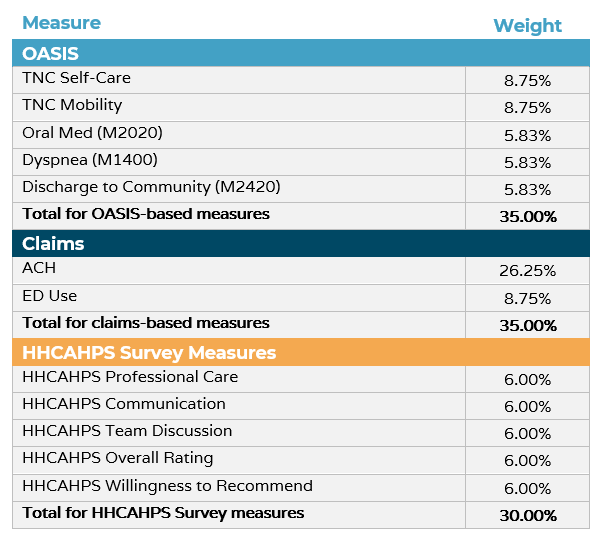In 2023, two significant changes have been introduced to home health: the new OASIS-E and the nationwide expansion of the home health value-based purchasing (HHVBP) program. Home health organizations must be knowledgeable of the new OASIS data set and the measures impacting the HHVBP Total Performace Score to optimize reimbursements and earn payment incentives.
HHVBP evaluates home health providers and rewards or penalizes them based on their quality of care. Home health agencies would receive a Total Performance Score (TPS) based on their performance compared to their improvement score and other agencies’ performance. At least 35% of the TPS in HHVBP will come from OASIS-based measures. See the table below:

OASIS-E and HHVBP
The implementation of the new OASIS-E supports the goal of improving interoperability between care settings. This is achieved by using identical data assessment items, which allows for a common standard for data set completion across all settings. This leads to increased interoperability as each setting uses the same criteria for data collection.
The way clinicians complete the OASIS-E data set will have a substantial effect on the organization’s reimbursement through value-based purchasing. Organizations will earn points for their OASIS-E data if they can show improvements in various areas, including:
- Reduction in dyspnea
- Better medication management
- Discharge to the community
- Increased self-care ability
- Improved mobility
It’s essential for home health organizations to complete the start of care and discharge OASIS data sets accurately, as CMS will assess the improvement between the two sets to determine the HHVBP scores. To demonstrate improvement, clinicians must gather input from all those involved in the patient’s care.
Further Guidance
The HHVBP Model is now in its first full performance year, starting on January 1, 2023, with CY 2023 being the performance year. The payment adjustment amounts for the program will be determined based on the performance of CY 2023.
Home health agencies are encouraged to review and analyze their existing data to identify opportunities for improvement. They can access their Pre-Implementation Performance Report (PIPR) in iQIES to see how they are doing in the expanded HHVBP Model. The PIPR includes information on the quality measure performance based on the last 12 months of data, compared to other HHAs nationally within their peer group. The PIPR provides feedback on the agency’s performance and helps them track their progress compared to their peers. The first PIPR will be available in July 2023 and will show their performance for CY 2023 (performance year) and CY 2025 (payment year). A sample report can be found on the Expanded HHVBP Model webpage.
Strengthening Your OASIS-E Documentation Process
To ensure the best outcome for your patients and to demonstrate improvement in the OASIS documentation, it is important to use your QA review program. The purpose of OASIS-E is to assess and document the progress of the patient’s health status, and this should be the top priority when completing the OASIS data sets.
With the implementation of the new OASIS-E and the home health value-based purchasing program, the accuracy of the OASIS data sets will play a crucial role in determining the organization’s reimbursement. The data collected in 2023 will impact the organization’s reimbursement in 2025, making it essential to start integrating improved OASIS processes now. Utilizing a QA review program will ensure that the patient’s goals are met and that their improvement is accurately documented in the OASIS documentation.

